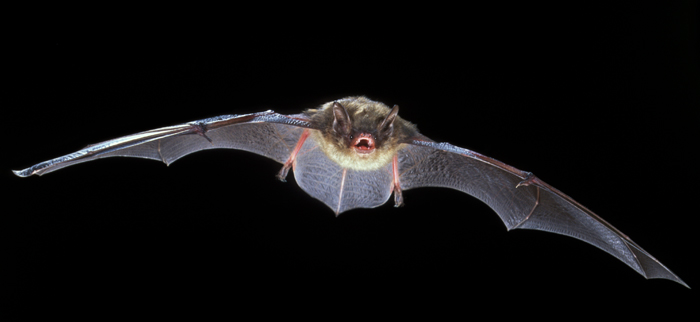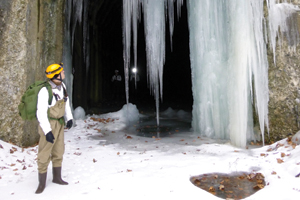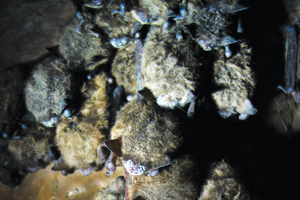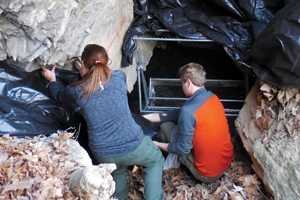The White-Nose Mystery: A silent killer of bats

Little brown bat; by Scott Altenbach
It sounds like a case made for Scooby Doo and the Mystery Machine, but unlike a cartoon, there is a very real danger facing Maryland bats each winter: Pseudogymnoascus destructans, the cause of the fatal white-nose syndrome. This cold-loving fungus attacks bats while they hibernate by growing on and into their skin. As a result, they constantly wake up and groom themselves, resulting in them burning up their fat reserves long before winter is over. Trying to survive, bats may even fly off looking for food and die in the process.

Winter survey; by Michelle Carter
Killer clues
The U.S. Fish and Wildlife Service coordinates white-nose syndrome response and works closely with Canadian counterparts to share research and results. Since the discovery of the fungus, seven North American, one Asian, and 13 European species have been confirmed with diagnostic symptoms. Those affected may not always display fungal growth, but instead behave strangely. For example, bats may roost near a cave’s entrance when they would normally seek deeper areas for more stable temperatures.
Surprisingly, some species have tested positive for the fungus, yet show no diagnostic signs of the disease. Of these species, five occur in North America, five in Asia and two in Europe.
The fungus is mostly spread through spores transmitted from bat-to-bat, but people can also transmit spores while working or recreating in caves. Despite prevention efforts, the fungus first appeared in Washington State during the winter of 2015-2016. As of July, white-nose syndrome has been detected in 29 American states, including Maryland and five Canadian provinces.
| White-nose syndrome has no known health implications to humans, and has only been observed in bats. |

Infected little brown bats; by Dan Feller
Maryland mortality
Natural Resources Ecologist Dan Feller was the first to find bats with white-nose in Maryland during the winter of 2009-2010. As seen in other northeastern states, Feller documented a devastating overall decline of 81 percent in the state’s hibernating population over the past five years.
The usual hibernation haunts in caves and mines have indeed become haunting due to the lack of bats. You may think that’s a stretch, but considering the number and type of insects they eat, you may get really bugged about this decline. One bat can eat a thousand insects per hour, and a colony of 150 literally eats tons of insects each summer. Beyond mosquitoes, they feast on beetles, flies, moths, stinkbugs and other major agricultural pests.
Research community response
Department biologists sought help from researchers and National Park Service biologists to aid with the intensive task of monitoring the syndrome’s effects. The Chesapeake & Ohio Canal lands encompass much of Maryland’s hibernacula, or hibernation sites. Since they can travel hundreds of miles between seasons, biologists needed to know how summer bats compare with wintering populations.

Examination; by Michelle Carter
A good way to sample large areas is to conduct driving surveys to record the echolocation calls the bats use to navigate and find food. Juliet Nagel—a doctoral candidate with the University of Maryland’s Center for Environmental Sciences Appalachian Lab—coordinated these efforts. Unfortunately, the results echoed those from the winter surveys, showing a decrease in calls of cave bats, such as little brown bats (96 percent), tricolored bats (95 percent) and northern long-eared bats (88 percent.)
Spring harps and summer nets
This documented decline made it imperative to initiate conservation strategies, such as learning where the most vulnerable species roost in the summer. Maryland has several regionally significant populations that hibernate in the state, including endangered eastern small-footed and threatened northern long-eared bats

Harp trap setup; by Beth Stevenson
To monitor these species and understand where they spend their time during the warmer months, researchers used harp traps to safely capture bats at cave, mine and tunnel entrances as they emerged from hibernation. Later, they set up mist nets made of fine mesh, to catch bats as they flew over streams and through forests at night. Researchers then used radio telemetry to track them to their roosts.
The National Park Service contracted Nagel to trap several tunnels in western Maryland, while Beth Stevenson, a research associate with Appalachian Lab, trapped the caves and mines. Six eastern small-footed bats have been tracked since 2011, and Stevenson’s crew caught two northern long-eared bats that they tracked this past summer.
Hope for the future
Some bats survive the killer fungus, but unlike other mammals such as rabbits and mice, they are very slow to reproduce and have only one or two young per year. It is going to take decades for populations to rebound, and they may never reach pre-fungus densities. Biologists have released bats with numbered bands, and observed that a small percentage continues to appear each winter in fungus-contaminated areas.

Northern long-eared bat; by Scott Altenbach
Much research has focused on learning about the fungus and finding a solution to the epidemic. Department biologists are cooperating in a study of white-nose syndrome transmission and surveillance led by Dr. Winifred Frick of the University of California Santa Cruz, now the Senior Director of Conservation Science with Bat Conservation International. Dr. Frick enlisted the help of biologists in six states to take swab samples of bats and the substrates where they were hibernating.
Maryland test results indicated all caves and mines tested positive for the fungus on bats and the wall substrate, but not the tunnels. Therein lies the mystery. All three abandoned railroad tunnels in Allegany County remain free of white-nose syndrome since the study began in 2012, and researchers remain at a loss to explain why.
The good news is one of the tunnels represents the best hibernacula in Maryland in terms of population numbers and species diversity. Spring emergence studies have revealed that about 1,400 bats of seven species hibernate there. If they remain free of the white-nose fungus, these locations will become regionally significant as a refuge for survivors. And that may be our light at the end of the tunnel.
Article by Dana Limpert—Wildlife and Heritage Service bat biologist and eastern region ecologist.
Appears in Vol. 19, No. 4 of the Maryland Natural Resource magazine, fall 2016.

